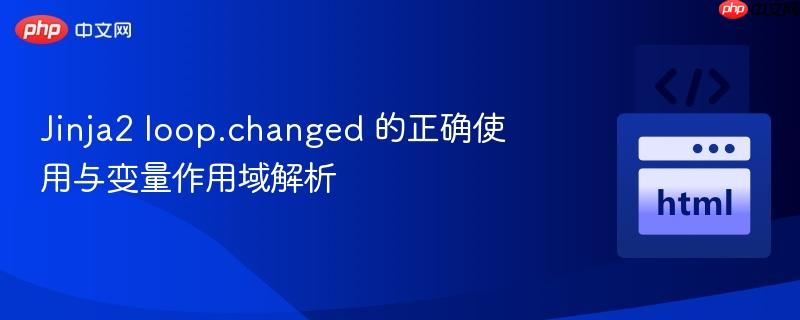
在 jinja2 模板中,loop.changed(value) 是一个非常有用的功能,它允许我们在循环迭代时检测某个特定值是否相对于上一次迭代发生了变化。这在需要根据数据分组或只在某个值首次出现时执行特定操作的场景中非常实用。例如,当我们需要遍历一个包含重复项的列表,但只想为每个唯一的 post_name 渲染一个特定的 html 结构时,loop.changed 就能派上用场。
然而,在使用 loop.changed 时,如果对 Jinja2 的变量作用域理解不深,可能会遇到一些意料之外的行为。
考虑以下 Jinja2 模板代码片段,其目的是在 post.post_name 发生变化时渲染一个包含图片链接的 div 块,否则渲染一个空 div:
{% for post in posts %}
{% if loop.changed(current_post) %}
<div>
<a href="{{ url_for('read', post_name=post.post_name) }}">
<img src="{{ url_for('static', filename='images/'+post.title) }}" alt="">
</a>
</div>
{% else %}
{% set current_post = post.post_name %} {# 在这里设置变量 #}
<div></div>
{% endif %}
{% endfor %}在上述代码中,开发者试图通过在 else 块中设置 current_post 变量来追踪 post.post_name 的变化。然而,实际运行结果可能与预期不符,即即使 post.post_name 发生了变化,也可能只有第一个 post 被正确渲染,后续的 post 都进入了 else 分支。
问题根源分析:
这个问题的核心在于 Jinja2 的变量作用域规则。当你在 else 块中使用 {% set current_post = post.post_name %} 定义变量时,这个变量 current_post 的作用域通常是局限于当前的 else 块或当前循环迭代的局部环境。这意味着在下一次循环迭代开始时,if loop.changed(current_post) 中的 current_post 可能并没有被正确地初始化或保留上一次迭代 else 块中设置的值。
loop.changed(value) 的内部机制是比较当前迭代传入的 value 与它自己内部为该 value 维护的上一次迭代的值。如果 current_post 在每次 if 检查时都无法获取到上一次 else 块中设置的正确值,那么 loop.changed 就无法进行有效的比较,从而导致逻辑错误。它可能总是认为 current_post 未定义或为 None,因此 loop.changed 的行为变得不可预测。
解决这个问题的方案非常简单且直接:不要尝试通过一个中间变量来追踪变化,而是直接将你希望 loop.changed 比较的实际值传递给它。
正确的做法是直接将 post.post_name 传递给 loop.changed:
{% for post in posts %}
{% if loop.changed(post.post_name) %} {# 直接传递 post.post_name #}
<div>
<a href="{{ url_for('read', post_name=post.post_name) }}">
<img src="{{ url_for('static', filename='images/'+post.title) }}" alt="">
</a>
</div>
{% else %}
{# 这里不再需要设置 current_post 变量 #}
<div></div>
{% endif %}
{% endfor %}为什么这样有效?
当 loop.changed(post.post_name) 被调用时,Jinja2 的 loop 对象会内部维护 post.post_name 在上一次迭代中的值。在每次新的迭代中,loop.changed 会将当前 post.post_name 的值与它内部存储的上一次迭代的值进行比较。如果两者不同,loop.changed 返回 True;否则返回 False。这种机制完全独立于模板中用户定义的变量作用域,因此能够确保正确的比较逻辑。
假设我们有一个 Flask 应用,其路由和数据模型如下:
Python 后端 (Flask):
from flask import Flask, render_template
from flask_sqlalchemy import SQLAlchemy
import datetime
app = Flask(__name__)
app.config['SQLALCHEMY_DATABASE_URI'] = 'sqlite:///site.db'
db = SQLAlchemy(app)
# 假设用户模型已存在,这里仅展示 Image 模型
class User(db.Model):
id = db.Column(db.Integer, primary_key=True)
username = db.Column(db.String(20), unique=True, nullable=False)
# ... 其他字段
class Image(db.Model):
id = db.Column(db.Integer, primary_key=True)
title = db.Column(db.String(120), nullable=False)
date_posted = db.Column(db.DateTime, nullable=False, default=datetime.datetime.utcnow)
img_location = db.Column(db.String(600), nullable=False)
mimetype = db.Column(db.String(10))
post_name = db.Column(db.String(150), nullable=False, unique=False)
user_id = db.Column(db.Integer, db.ForeignKey('user.id'), nullable=False)
def __repr__(self):
return f"Image('{self.title}', '{self.post_name}')"
# 示例路由
@app.route("/", methods=["GET", "POST"])
def index():
# 假设 current_user 是通过 Flask-Login 等库管理的用户对象
# 为简化示例,这里直接模拟 posts 数据
# 实际应用中 posts = Image.query.all()
# 模拟数据,包含重复的 post_name
posts_data = [
Image(title='image1.jpg', post_name='Hz7g5LlonYWG', user_id=1, img_location=''),
Image(title='image2.jpg', post_name='Hz7g5LlonYWG', user_id=1, img_location=''),
Image(title='image3.jpg', post_name='dHjeIv8guNVE', user_id=1, img_location=''),
Image(title='image4.jpg', post_name='dHjeIv8guNVE', user_id=1, img_location=''),
Image(title='image5.jpg', post_name='ZcLji2uNgT1V', user_id=1, img_location=''),
]
# 在实际应用中,你可能需要确保 posts 是按 post_name 排序的,
# 这样 loop.changed 才能正确地检测到连续的变化。
# 例如:posts = Image.query.order_by(Image.post_name).all()
# 假设 current_user 存在,此处仅为示例
class MockUser:
is_authenticated = True
username = "testuser"
current_user = MockUser()
return render_template("index.html", current_user=current_user, posts=posts_data)
# 确保在应用启动时创建数据库表 (仅用于测试)
with app.app_context():
db.create_all()
# 可以在这里添加一些测试数据
if __name__ == '__main__':
app.run(debug=True)Jinja2 模板 (index.html):
<!DOCTYPE html>
<html>
<head>
<meta name="viewport" content="width=device-width, initial-scale=1.0">
<title>Posts Index</title>
<link rel="stylesheet" href="{{ url_for('static', filename='index.css') }}">
</head>
<body>
{% with messages = get_flashed_messages() %}
{% if messages %}
{% for message in messages %}
<div class="flash-msg">{{ message }}</div>
{% endfor %}
{% endif %}
{% endwith %}
<script src="{{ url_for('static', filename='index.js') }}"></script>
<div id="first">
<input type="text" id="searchBar" name="searchBar">
{% if current_user.is_authenticated %}
<a href="{{ url_for('user', username=current_user.username) }}"><img src="{{ url_for('static', filename='profile-icon.png') }}" alt="" id="profileIcon"></a>
<a href="{{ url_for('logout') }}" id="logout-btn">Logout</a>
{% else %}
<a href="{{ url_for('login') }}"><img src="{{ url_for('static', filename='profile-icon.png') }}" alt="" id="profileIcon"></a>
{% endif %}
</div>
<div id="posts-container">
<h3>Unique Posts Display</h3>
{% for post in posts %}
{% if loop.changed(post.post_name) %} {# 正确使用 loop.changed #}
<div class="post-item">
<a href="{{ url_for('read', post_name=post.post_name) }}">
{# 假设 'images/' 路径下有对应的图片文件,例如 'image1.jpg' #}
<img src="{{ url_for('static', filename='images/'+post.title) }}" alt="{{ post.title }}">
</a>
<p>Post Name: {{ post.post_name }}</p>
</div>
{% else %}
{# 对于重复的 post_name,可以渲染一个空 div 或不渲染任何内容 #}
<div class="duplicate-item">
<!-- This post_name is a duplicate of the previous one. -->
</div>
{% endif %}
{% endfor %}
</div>
</body>
</html>在上述修正后的模板中,只有当 post.post_name 发生变化时,才会渲染包含图片和链接的 div.post-item。对于 post_name 相同的连续项,将渲染 div.duplicate-item。
# 示例:在 Flask 中对查询结果进行排序 posts = Image.query.order_by(Image.post_name).all()
loop.changed 是 Jinja2 模板中一个强大的工具,用于处理基于数据变化的渲染逻辑。然而,它的正确使用依赖于对 Jinja2 变量作用域的清晰理解。通过直接将需要比较的属性(如 post.post_name)传递给 loop.changed,我们可以避免因变量作用域限制而导致的逻辑错误,从而确保模板按照预期行为渲染。掌握这一技巧将有助于编写更健壮、更易维护的 Jinja2 模板。
以上就是Jinja2 loop.changed 的正确使用与变量作用域解析的详细内容,更多请关注php中文网其它相关文章!

每个人都需要一台速度更快、更稳定的 PC。随着时间的推移,垃圾文件、旧注册表数据和不必要的后台进程会占用资源并降低性能。幸运的是,许多工具可以让 Windows 保持平稳运行。

Copyright 2014-2025 https://www.php.cn/ All Rights Reserved | php.cn | 湘ICP备2023035733号